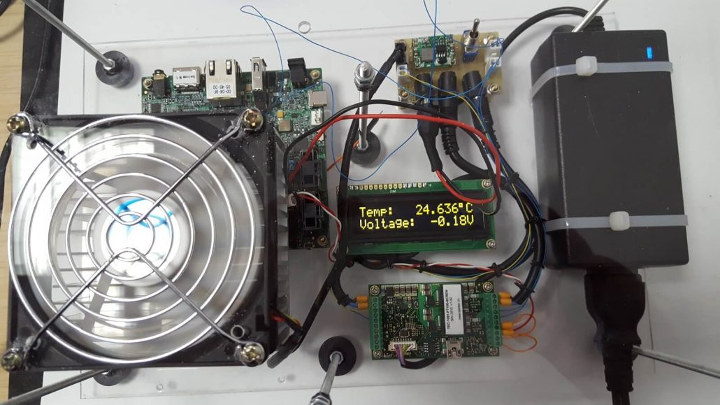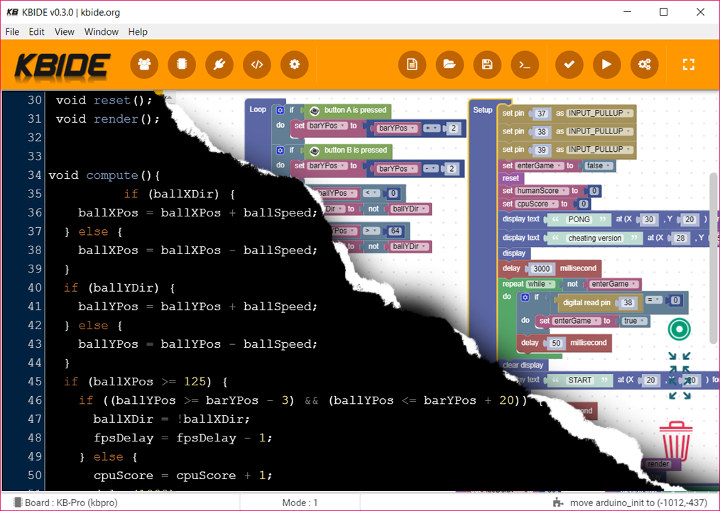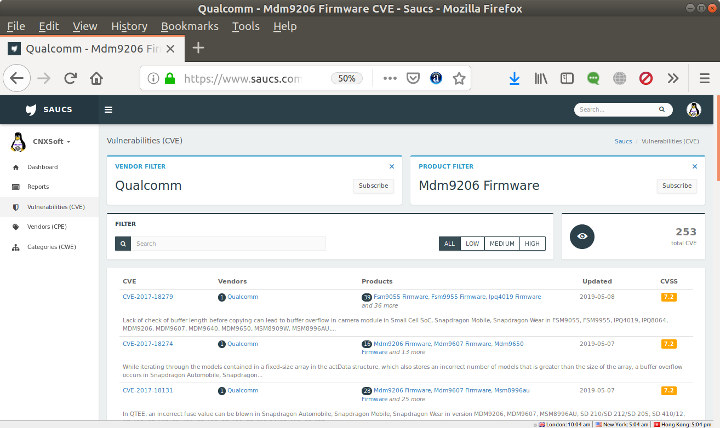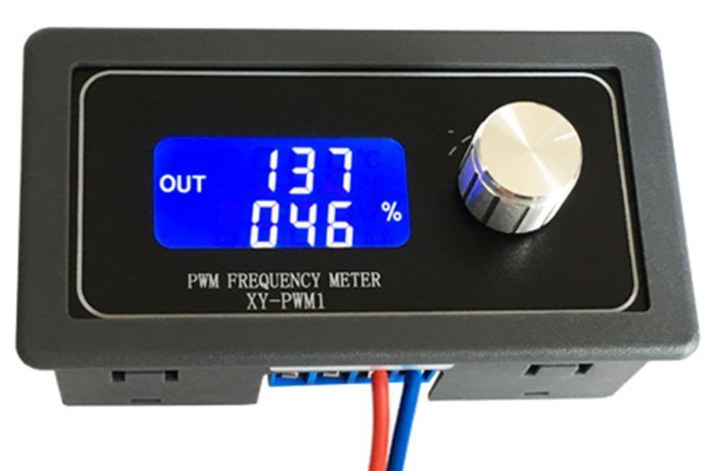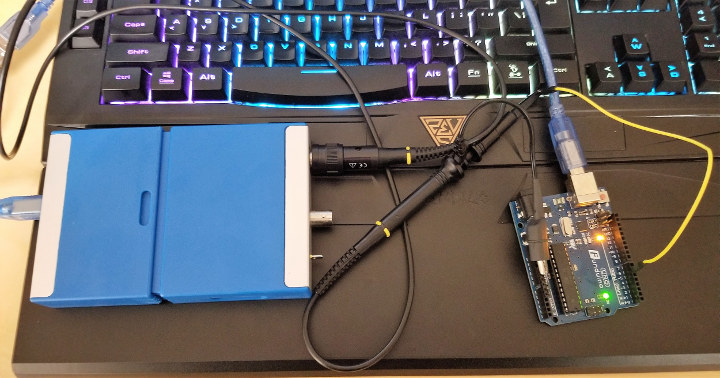If you don’t quite understand the title of this post, don’t worry that’s normal! So let me explains. TPMP stands for Thermo-regulated Power Measurement Platform, and PVT (Power, Voltage, Temperature) characterization is a step in semiconductor manufacturing that involves testing wafers with various voltages, clock frequencies, and temperatures – known as Operating Performance Points (OPP) – to see how the properties of the wafer change. The equipment required to perform this characterization is usually very expensive, and the process takes time. So BayLibre was tasked by one of their customers to automate the process, and find a lower cost solution. That’s how BayLibre TPMP came to life. The TPMP is comprised of six main hardware components in order to measure NXP i.MX8 processor die-temperature: Peltier element Meerstetter TEC-1091 Peltier controller Fan Heatsink temperature sensor Chip external temperature sensor LCD display to monitor temperature, voltage, and current. The TEC-1091 chip controls […]
Programmable USB Hub Power Adjustable with Built-In Dev Board (Crowdfunding)
Capable Robot Components has launched its Crowd Supply campaign for the Programmable USB Hub in June of 2019. The hub is a feature rich and component rich USB hub that has a dev board built-in. The entire system is housed in an extruded aluminum case, with all the numbering and lettering and port attachments in brilliant white. Control power and data flow, directly through the unit. The first 40 units are sold out. There seem to be good reasons why these USB Hubs sell out fast. There was an in-depth article written on a similar hub some time ago. Inside the enclosure is an array of functionality packed neatly onto a small board. There are 4x USB 2.0 ports that are High-Speed downstream ports and 1x upstream port, a 5th endpoint on the USB hub exposes 2 12C buses via Sparkfun Qwiic connectors, the UART and 2X GPIO. The input power is […]
KB-IDE Open Source IDE Supports ESP-IDF, Arduino, and Visual Programming for ESP32 Boards
We’ve previously written about MakerAsia when covering their KBX Extension case for Kidbright ESP32 educational board. The company has now launched a new product, but it’s not an hardware platform, and instead KB-IDE is an open IDE (Integrated Development Environment) ESP32 boards. The IDE is suitable whatever your level from kids getting started with supports visual programming, to Arduino programming, and even the official Espressif ESP-IDF framework for more experienced makers. The IDE comes with with a Board Manager, a Plugins System and works with any Arduino Library out of the box. Made with Vue.js framework, KB-IDE is open source with the code available on Github. You can install a binary release, or build it from source for Windows, Linux, or Mac OS. Since it’s open source, it’s also expandable so makers can customize it, for instance by adding new architectures (AVR and ARM are already planned), new boards, creating […]
SAUCS is a Search Engine for Security Vulnerabilities (CVE Database)
Every so often we hear about critical security vulnerabilities in the news, but new ones are actually discovered daily, so it would be nice to have some sort of search engine to find out which known security vulnerabilities a given product or processor may have before purchasing it, or even more importantly starting a project. SAUCS does just that by having robots checking out the CVE update list, parsing the XML feed and formatting it. You can search for products or process, or subscribe to the vendors and products you want, and receive an email as soon as new changes as detected. I found out about SAUCS thanks to a comment from Thomas who pointed out the Qualcomm MDM9607 processor found in Quectel EC25 LTE module had a fairly long list of CVE (Common Vulnerabilities and Exposures) entries while using the default? firmware as shown in the screenshot above. Each […]
RISC-V Compliance Tests Aim to Address RISC-V Fragmentation
In the x86 world, one operating system image can usually run on all hardware thanks to clearly defined instruction sets, hardware and software requirements. Arm provides most flexibility in terms of peripherals, while having a fixed set of intrusions for a given architecture (e.g. Armv8, Armv7…), and this lead to fragmentation, so that in the past you had to customize your software with board files and other tweaks, and provide one binary per board, leading to lots of fragmentation. With device trees, things improved a bit, but there are still few images that will run on multiple boards without modifications. RISC-V provides even more flexibility that Arm since you can mess up with the instructions set with designers able to add or remove instructions as they see fit for their application. One can easily imagine how this can lead to a complete mess with binary code only running on a […]
This $4 PWM Signal Generator Outputs Pulses up to 150 KHz
When I think about signals generators, I usually think about equipment that costs several hundred dollars, but depending on your needs you could also use much cheaper solutions like PSLab electronics lab board ($65), or an Arduino board to generate a signal. Another option is to get an ultra-cheap signal generator such as XY-PWM1 which I found on ICStation for just $4.19.Its function is limited to PWM pulses from 1Hz to 150KHz, with a voltage range between 3.3V and 30V. XY-PWM1 specifications: LCD display showing frequency and duty cycle Voltage Range – DC 3.3V-30V Frequency range Normal mode: 1Hz~150KHz Precise mode: 1Hz~15KHz Frequency accuracy: 2% Duty cycle accuracy 1% in Normal mode 0.1% in Precise mode Duty cycle range – 0.00%-100% Output Current – About 5-30mA Dimensions – 79x43x37mm Temperature Range – -40℃~85℃ Humidity – 0%~95% RH There’s no obvious button to select mode, but apparently, you’d just need to use […]
SainSmart DS802 Review – A Dual Channel Virtual PC Oscilloscope
Hey Karl here. Today we’re going to look at the SainSmart DS802 Dual-channel oscilloscope. I have always wanted to have an oscilloscope and add it to my tools. When SainSmart asked to review the DS802, I was pretty excited. I can get my nerd on and troubleshoot all kinds of things. A couple weeks later it arrives and my anxiety kicks in. How the heck do I review an oscilloscope. I used an oscilloscope in high school in a class called principles of technology. But we never really went into much depth and only looked at the signals generated by a signal generator. I understand the basics. This is written from a perspective of a complete noob. SainSmart DS802 Specs Pulled directly from Sainsmarts website: Channels: 2 Analog channels Interface: USB 2.0 Output: 1k HZ amplitude 1.5V, 50% duty cycle square wave signal Maximum sampling rate: 80 MSps per channel […]
ATORCH USB PD Power Meter Comes with USB type-C, type-B, and type-A Ports
Most smartphones are charged over a USB port, and many single board computers are powered by a micro USB or USB type-C port, and USB power meters such as USB Charger Doctor can be useful to evaluate phone chargers, as well as measure power consumption of SBCs. With the launch of the USB type-C connector and features such as USB PD (Power Delivery), old USB power meters are not adapted to the new standard since the connector and most importantly voltages are different, so we need USB PD compatible meters like Satechi USB Type-C power meter. Today, I decided to look for more options on Aliexpress, and you’ll find many USB-C power meters with the cheapest models going for under $5 shipped. However, ATORCH J7-c model caught my attention since it supports both USB type-C, micro USB type-B, and USB type-A power sources, so you can keep using the same […]


